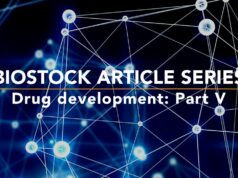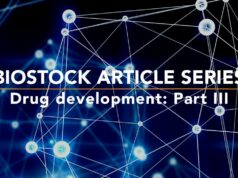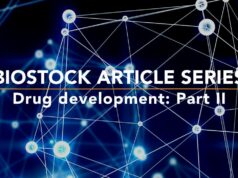
Drug development – Making treatments available
The regulatory framework aims to ensure ethical, safe and data-driven drug development. At the same time, the strict rules lead both to a longer development process and increased costs for drug companies. In this fourth article in BioStock’s series on drug development, we take a closer look at some of the regulatory fast-track options that regulators have introduced in recent years, the purpose of which is to speed up the development process and give patients quicker access to new drugs.
Sometimes, early studies indicate that a drug candidate has the potential to be ground-breaking for the treatment of a disease. For the individual patient, this could mean a significantly better prognosis, with longer than expected survival and/or a more tolerable life. However, it can take many years before the candidate reaches the market – provided that it passes all stages of development – which on an individual level may mean that it is too late for the treatment to be of any help.
In recent years, the regulatory authorities in both the US and Europe – FDA and EMA, respectively – have introduced directives to shorten the time it takes for certain types of drugs to pass through the clinical development stages in accordance with current regulations, and thus make the drug available to the patient group in question more quickly.
Read also:
Drug development part I – The four phases
Drug development part II – The challenges
Drug development part III – A regulatory obstacle course
Drug development part V – The success of orphan drugs
Four FDA directives
The FDA currently has four directives aimed at accelerating access to drugs for the treatment of serious diseases: Fast Track, Breakthrough Therapy, Accelerated Approval, and Priority Review.
1. Fast Track
Fast Track is designed to give patients with serious medical conditions access to new drugs significantly earlier than the traditional regulatory process allows. To meet Fast Track requirements, the drug must fill an unmet medical need, which usually means that the drug addresses a disease for which there are no available treatments.
Fast Track designation gives companies access to more frequent communication with the FDA, which includes assistance with the design of clinical studies to meet regulatory requirements. The designation also means that the candidate in question is eligible for Accelerated Approval and Priority Review – provided that the candidate meets certain requirements (see below).
2. Breakthrough Therapy
Breakthrough Therapy designation is similar to Fast Track and has the same requirements. However, an additional requirement is the presentation of preliminary clinical data that points to a significant improvement over existing drugs in terms of irreversible morbidity, mortality, or severe disease symptoms.
The designation gives the candidate access to the agency’s guidance on clinical drug development, as well as organisational support from senior executives at the FDA – something that Fast Track does not provide.
The majority of drugs that have received Breakthrough Therapy designation are approved for market launch if they meet so-called “clinically significant” endpoints, or have a “clinical benefit,” i.e. statistically significant clinical data indicating that the experimental treatment in question is able to improve survival times.
3. Accelerated Approval
Accelerated Approval is given to candidates intended for serious conditions that meet surrogate endpoints – clinical data points with the potential to predict a clinical benefit of a drug, but which requires less time to reach in testing.
A good example of a surrogate measure is progression-free survival (PFS) in cancer – how long a cancer patient lives without signs of tumour growth or metastasis. It takes significantly less time to be able to measure and evaluate PFS compared to the ultimate treatment goal – survival. This is because the tumour will grow or metastasize before the patient dies.
In cases where a drug receives market approval based on surrogate endpoints, the FDA requires additional clinical studies to be conducted after market launch. This is to confirm that the drug also has an effect on the intended clinical endpoint.
4. Priority Review
Priority Review designation is intended to shorten the regulatory review process from an average of 10 months to six months or less when a New Drug Application (NDA) or a Biologics License Application (BLA) is submitted to the FDA. This review priority is assigned to drug candidates that could significantly improve the safety or efficacy of a treatment, diagnosis, or preventive measure of a serious medical condition.
Two European initiatives
EMA has, in turn, implemented two initiatives with similar goals to those of the FDA versions above: Priority Medicines (PRIME) and Adaptive Pathways (AP).
1. Priority Medicines
The criteria for obtaining the PRIME designation are mainly based on the candidate demonstrating the potential to offer a significant therapeutic advantage over existing drugs, thereby benefiting patients with unmet medical needs.
Drug candidates eligible for PRIME receive regulatory support ranging from designing clinical studies to applying for market approval, including accelerated assessment, similar to the FDA’s Priority Review. Accelerated assessment means that the regulatory authority will prioritise a Marketing Authorisation Application for a drug with a PRIME designation over a standard application. This translates to a review time reduced from 210 days on average for a standard application to a maximum of 150 days for a PRIME application.
2. Adaptive Pathways
Adaptive pathways (APs) is an innovative tool within healthcare systems and part of EMA’s strategy to give patients with serious illnesses earlier access to experimental drugs. The process is based on already existing regulatory processes, such as scientific advice and compassionate use (more on this below).
Assuming the candidate is targeting an unmet medical need, the AP goes out for a phased approval. The drug is first approved for a small patient group, and when the evidence base is expanded through data from clinical practice within the selected group, the approval is extended to a larger patient group.
In the event of an AP, talks with the regulator regarding incremental approval will begin even before phase II. This is followed by rigorous talks for the rest of the clinical development until a possible market approval.
Compassionate use, Right-to-Try
In rare cases, the AP initiative exempts drugs from the strictest rules in order to give already dying patients the chance to try an experimental treatment that has not yet been approved. This can be done in accordance with the compassionate use provision established by the EMA, which gives patients access to a treatment as early as late phase II.
Similar provisions exist in the United States. The FDA has three programmes that can give patients earlier access to experimental drugs — one for individual patients, one for medium-sized patient populations, and one for widespread use.
In 2021, the US passed a law allowing patients to access non-approved drugs without having to go through the FDA. The law, known as Right-to-Try, gives patients the right to turn directly to the company that develops a drug and ask to try it. It is thus exclusively up to the company to evaluate whether the evidence regarding safety and efficacy is strong enough and to assess whether the patient is suitable for the candidate in question. Although the FDA is not directly involved, a drug eligible for Right-to-Try must have passed the safety threshold set by a phase I clinical trial and be subject to a new drug application (NDA) to phase II.
Pros and cons of faster approval
Right-to-Try has gained appreciation for its commitment to giving terminally ill patients faster access to potential treatments. At the same time, the law has been criticised by experts who are sceptical to the fact that experimental drugs reach patients without first having been quality assured by the FDA.
Another initiative intended to accelerate drug development that has received much criticism is the Orphan Drug Act of 1983 (see part III of this series of articles). The Act means that the FDA must offer incentives to drug developers who are willing to develop drugs intended to treat rare diseases. The initiative has been successful, but, at the same time, it has led to speculation that companies are taking advantage of these incentives to maximise their profits and create a monopoly on the orphan drug market.
In 2020, the EU followed in the footsteps of the FDA and introduced the Committee for Orphan Medical Products (COMP), which gives drug development companies similar incentives to develop orphan drugs as the Orphan Drug Act does in the US, but with somewhat stricter specifications.
To summarise, the initiatives introduced by the regulators have influenced drug development to varying degrees and has prompted both praise and criticism. One law that stands out in this regard is the Orphan Drug Act, and therefore the next – and final – part of this article series will be devoted exclusively to that Act and how it has shaped drug development in recent years.


